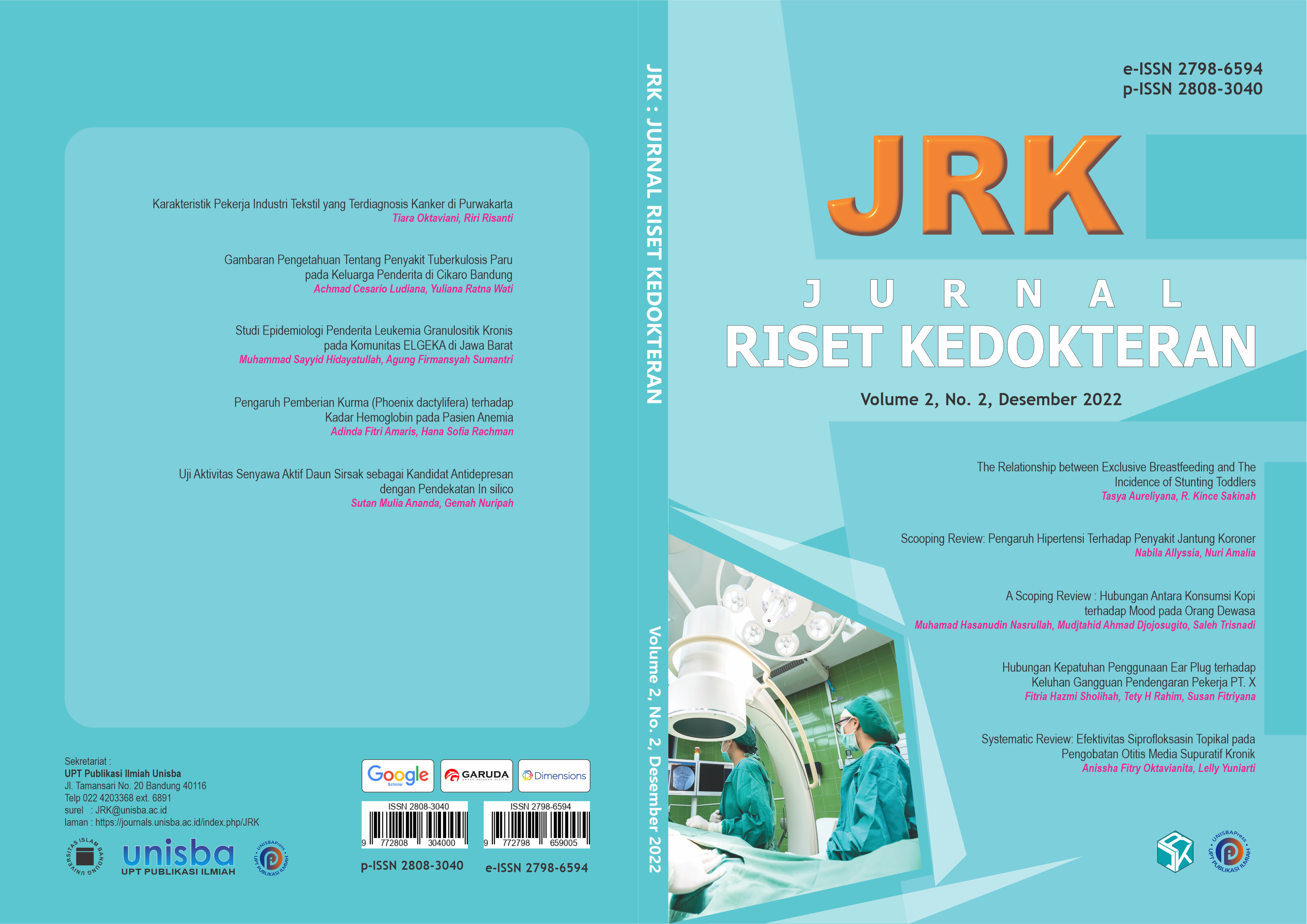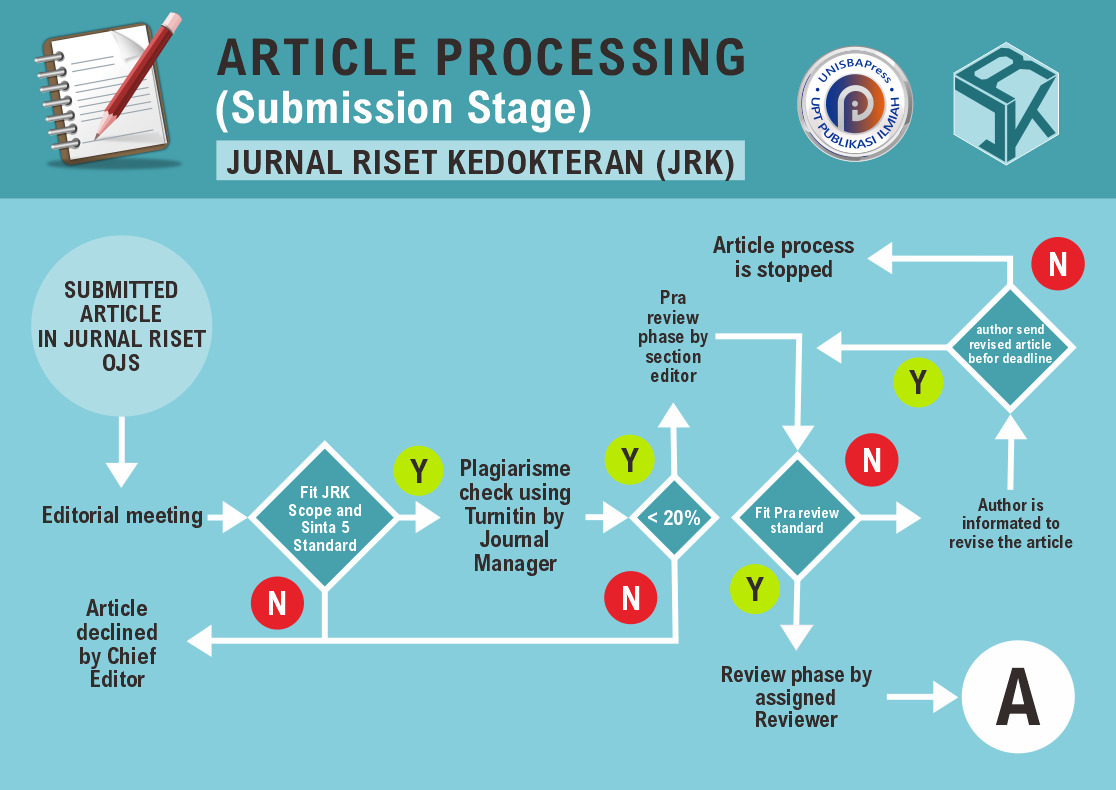Uji Aktivitas Senyawa Aktif Daun Sirsak sebagai Kandidat Antidepresan dengan Pendekatan In silico
DOI:
https://doi.org/10.29313/jrk.vi.1552Keywords:
Antidepresan, Daun Sirsak, In silicoAbstract
Abstract. Apart from conventional medicines, depression can be treated with herbal remedies such as soursop (Annona muricata L.) leaves. The purpose of this study was to determine the effectiveness and mechanism of the active compound of soursop leaves (Annona muricata L.) as an antidepressant drug using the in silico approach. In this study, the in silico method was carried out with the help of computer devices and online data bases such as PubChem, SwissTargetPrediction, and STRING to analyze the target protein. This research was conducted in March-December 2020. The results showed 13 active compounds of soursop leaves (Annona muricata L.) can bind to eight target proteins, namely ACHE (acetylcholinesterase), ADRA2C (Alpha-2C adrenergic receptor), DRD1 (D1A dopamine receptor), DRD2 (D2 dopamine receptor), HTR2A (5-hydroxytryptamine receptor 2A), HTR2C (5-hydroxytryptamine receptor 2C), MAOA (Monoamine oxidase A) and SLC6A3 (Sodium-dependent dopamine transporter). The conclusion of this study that the active compounds contained in soursop leaves (Annona muricata L.) can affect the receptors and metabolic processes of dopamine, norepinephrine, and serotonine.
Abstrak. Selain dengan obat-obatan konvensional, depresi dapat diobati dengan pengobatan herbal seperti daun sirsak (Annona muricata L.). Tujuan penelitian ini adalah untuk mengetahui efektivitas dan mekanisme senyawa aktif daun sirsak (Annona muricata L.) sebagai obat antidepresan dengan pendekatan in silico. Pada penelitian ini, metode in silico dilakukan dengan bantuan perangkat komputer dan data base online seperti PubChem, SwissTargetPrediction, dan STRING untuk menganalisis protein target. Penelitian ini dilakukan pada bulan Maret−Desember 2020. Hasil penelitian menunjukkan 13 senyawa aktif daun sirsak (Annona muricata L.) dapat berikatan dengan delapan protein target yaitu ACHE (acetylcholinesterase), ADRA2C (Alpha-2C adrenergic receptor), DRD1 (D1A dopamine receptor), DRD2 (D2 dopamine receptor), HTR2A (5-hydroxytryptamine receptor 2A), HTR2C (5-hydroxytryptamine receptor 2C), MAOA (Monoamine oxidase A) dan SLC6A3 (Sodium-dependent dopamine transporter). Kesimpulan penelitian ini senyawa aktif yang terkandung dalam daun sirsak (Annona muricata L.) dapat memengaruhi reseptor dan proses metabolisme dopamin, norepinefrin dan serotonin.
References
M. Marcus, M. Yasamy, O. M. Van, and D. Chisholm, “Depression, a global public health concern,” World Fed. Ment. Heal., pp. 6–8, 2012.
World Health Organization, “Depression and other common mental disorders,” Depress. other common Ment. Disord., pp. 5–20, 2017.
American Psychiatric Association, Diagnostic and statistical manual of mental disorders. Washington DC, 2013.
A. Wulandari and T. Purnomowati, A; Wahmurti, “Deteksi disfungsi endotel pada gangguan depresi mayor dengan pengukuran endothelial-dependent flow-mediated vasodilatation,” Glob Med Heal Commun, vol. 5, no. 1, pp. 27–32, 2017.
C. Oakley and M. A, “Rapid psychiatry. 2nd ed. West Sussex: Wiley-Blackwell,” pp. 49–50, 2010.
B. G. Katzung, Basic and clinical pharmacology, 14th ed. San Fransisco: McGraw-Hil, 2017.
B. Sadock, V. Sadock, and P. Ruiz, Kaplan and Sadock’s synopsis of psychiatry: behavioral sciences/clinical psychiatry, 11th ed. New York: Wolters Kluwer, 2015.
L. Bjornlund, Depression (diseases & disorders), 1st ed. New York: Lucent Books, 2010.
R. Ningtyas, M. Puspitasari, and S. KA, “Review artikel : farmakoterapi depresi dan pengaruh jenis kelamin terhadap efikasi antidepresan,” Farmaka, vol. 16, no. 2, pp. 186–201, 2016.
D. David and D. Gourion, “Antidepressant and tolerance: determinants and management of major side effects,” Encephale, vol. 42, no. 6, pp. 553–61, 2016.
M. Rajput, S. Sinha, V. Mathur, and P. Agrawal, “Herbal antidepressants,” Int J Pharm Front Res, vol. 1, no. 1, pp. 159–69, 2011.
L. Liu, C. Liu, Y. Wang, P. Wang, Y. Li, and B. Li, “Herbal medicine for anxiety, depression and insomnia,” Curr Neuropharmacol, vol. 13, no. 4, pp. 481–93, 2015.
M. Khurshid, “Drug discovery and in silico techniques: a mini-review,” Enzym Eng, vol. 4, no. 1, pp. 1–3, 2014.
K. Timotius, Pengantar metodologi penelitian: pendekatan manajemen pengetahuan untuk perkembangan pengetahuan. Yogyakarta: Penerbit Andi, 2017.













